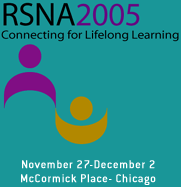
Abstract Archives of the RSNA, 2005
SST13-03
Comparison of Ultrasonography, Nuclear Scintigraphy, and MRCP in the Evaluation of Biliary Atresia
Scientific Papers
Presented on December 2, 2005
Presented as part of SST13: Pediatric (Gastrointestinal)
Raju Sharma MD, Presenter: Nothing to Disclose
Ruth Palle, Abstract Co-Author: Nothing to Disclose
Arun Kumar Gupta MD, Abstract Co-Author: Nothing to Disclose
Viresh Bhatnagar, Abstract Co-Author: Nothing to Disclose
To prospectively compare the accuracy of Sonography, HIDA scan and MRCP for the diagnosis of biliary atresia using per-operative cholangiogram as gold standard.
Twenty seven infants with persistent conjugated hyperbilirubinemia underwent sonography (USG), HIDA scan and MRCP. On USG, the length of the gall bladder and presence of triangular cord (TC) were assessed. HIDA scan was performed after a 5 day course of phenobarbitol pre-treatment. MRCP was performed on a 1.5 T Siemens MR scanner using HASTE sequence. Per-operative cholangiogram (POC) was performed in all infants with suspected biliary atresia and choledochal cyst. In patients with neonatal hepatitis, liver biopsy or clinical follow up were used as gold standard.
The final diagnosis was biliary atresia in 14 patients, neonatal hepatitis in 7 and choledochal cyst in 6 patients. On USG the triangular cord sign was seen in 13 out of 14 patients of biliary atresia and was not seen in any patient of neonatal hepatitis. The sensitivity of USG using triangular cord sign in the diagnosis of biliary atresia was 90.9%, specificity was 100% and diagnostic accuracy was 95.8%. The sensitivity of HIDA scan was 100% in the diagnosis of biliary atresia with accuracy of 60.8%, but specificity was as low as 27%. MRCP correctly diagnosed all patients with biliary atresia and choledochal cyst. However it was able to diagnose neonatal hepatitis in 57% of patients. Periportal hyperintensity on T2W sequence was found to be a specific finding for billiary atresia as it was seen in 92% patients. The diagnostic accuracy of MRCP for biliary atresia was 87.5%, sensitivity was 100%, specificity 76.9%, positive predictive value 78.5% and negative predictive value was 100%.
USG and MRCP have a high accuracy in differentiating biliary atresia from other causes of infantile cholestasis. HIDA is unable to differentiate neonatal hepatitis from biliary atresia when gut activity is absent and is also fallacious in diagnosis of choledochal cyst.
Sharma, R,
Palle, R,
Gupta, A,
Bhatnagar, V,
Comparison of Ultrasonography, Nuclear Scintigraphy, and MRCP in the Evaluation of Biliary Atresia. Radiological Society of North America 2005 Scientific Assembly and Annual Meeting, November 27 - December 2, 2005 ,Chicago IL.
http://archive.rsna.org/2005/4417742.html

